This funny dialogue corresponds to The Tesmophorians , a comedy written by Aristophanes in 411 BC. which takes place during the Tesmoforias, homonymous festivals that were celebrated in honor of the goddess Demeter and her daughter Persephone. When the Athenians plan to take revenge on Euripides for the grotesque image he gives of them in his plays, the playwright sends his mother-in-law Mnesilochus disguised as a woman to spy on them at a meeting held at the house of the effeminate Agathon and speak in his favour. But they discover the intruder and report him to the Pritaneo.
In the Hellenic world, the Pritaneum was the seat of executive power, usually located in the Agora. There the sacred fire of Hestia (the daughter of Cronus and Rhea, sister of Zeus, who stayed away from the disputes between men and gods, constituting the antecedent of the Roman Vesta) was kept, public banquets were held there, the grain reserves were kept and the fifty pritans gathered there (one for each tribe) selected from among the five hundred of the Boulé (the Council) to exercise government.
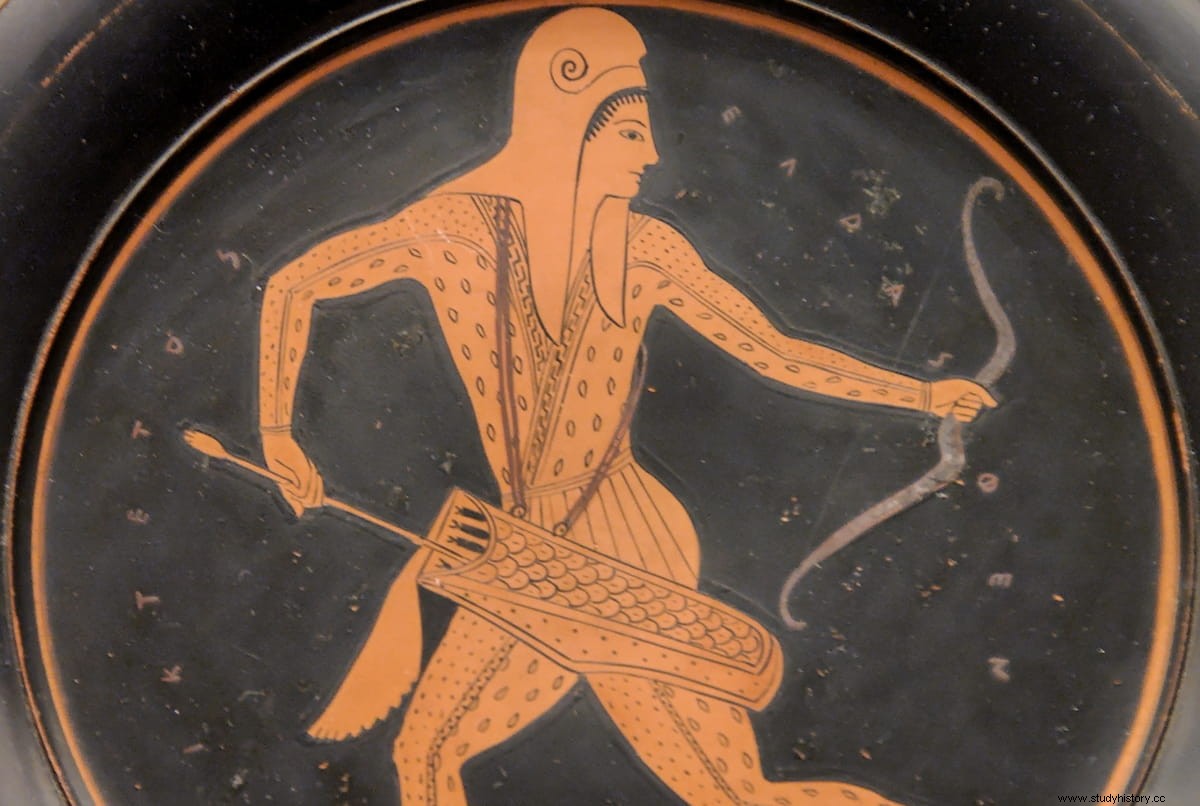
Well, the Pritans needed an armed body that was in charge of enforcing the laws to guarantee the eukosmía (order). In times of the tyrants, this police work was carried out by the doríforos , their respective personal guards, but in the democratic era several bodies were developed, such as the agoranomos (rural market inspectors), the astinomos (urban inspectors), the women's inspectors and the Scythian archers. And this is where we have to refer again to the dialogue of Las Tesmoforiantes with which we open the article.
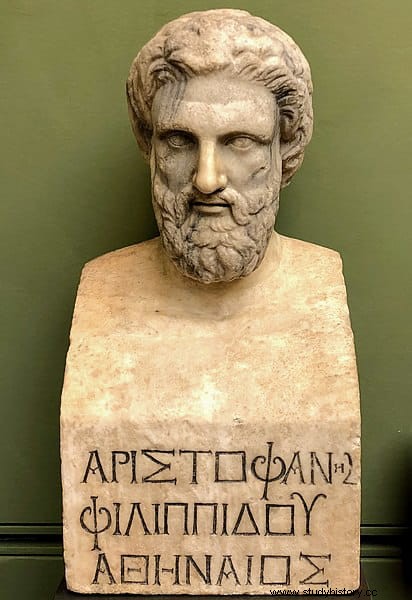
As you can read, the guard in charge of the arrest of Mnesilochus is named as an archer. In the translation of the dialogue, the nuances of the language that he uses are lost, full of barbarism and that originates a comic effect that is difficult to reproduce. The original Greek used by the archer is choppy, with a lax pronunciation (lenis) that omits the sigma consonants. and nu at the end of words, just as it replaces the first with the xi . Why? Because the character is not an Athenian, not even a Hellenic, but a Scythian. The consequent question is:what led Aristophanes to put a Scythian as a policeman in Athens?
The answer refers to the toxotai skythai or Scythian archers, also called speusinioi in reference to a certain Speusinos, who would have been the founder of that curious body. Obviously, it was not made up of citizens but of foreigners and also demosioi , that is, slaves owned by the State. This type of slavery allowed the sufferer a certain degree of autonomy and to work in various fields (crafts, commerce or, as in this case, police) in exchange for the payment of an apophora (fee), which allowed them to earn money and sometimes even buy their freedom.
Initially there were three hundred, according to Andócides, who also adds that they were bought, not captured (perhaps because they were more reliable than the local ones), after the peace signed between Athens and Sparta in the year 451 BC. That number appears more than once in the history of Ancient Greece:three hundred were the Spartans of Leonidas at Thermopylae, three hundred were the champions selected by Argos and Sparta to fight avoiding large-scale war... However, speaking of war, the Scythian archers would increase their number to twelve hundred later, which is interpreted as an extension to military functions.
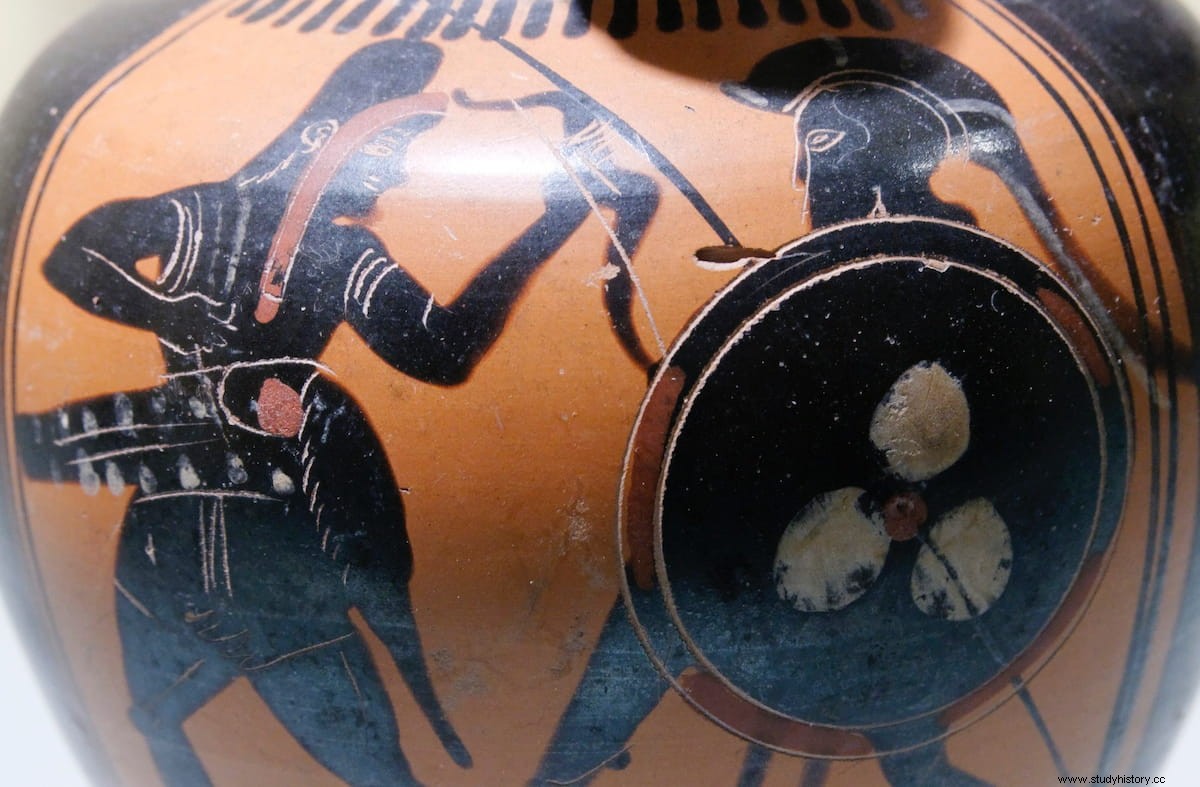
This seems to be proven by some representations of that force on Attic vessels, in which they are seen together with hoplite heroes, although there are those who think that it is only an iconographic convention and would not represent true Scythians, only servants dressed in their fashion. In any case, most of these pieces are from the 6th century BC, so said warrior function would have had that precedent -surely mercenary- and it is disputed whether it was really related to the later body.
In fact, the sources are confusing because they use the word archer for both the Scythians and the Greek soldiers who used that weapon and, on the other hand, some historians consider that a thousand was an excessive number of troops for a city the size of Athens. , which at that time would be around a quarter of a million inhabitants. Of course, it must be taken into account that more than half were slaves, around seventy thousand would be foreigners and there would only be about forty thousand with citizenship that granted political rights.
A fragment of the Suda (a Byzantine encyclopaedia from the 10th century AD), confirmed by Aristophanes, says that Scythian archers originally camped in wooden tents or barracks in the middle of the Agora, but later moved to the Areopagus when more space was probably needed in the square because of the urban growth experienced by the city, derived from economic prosperity. In any case, it must have been a curious spectacle for the citizens, due to the exoticism of those people.
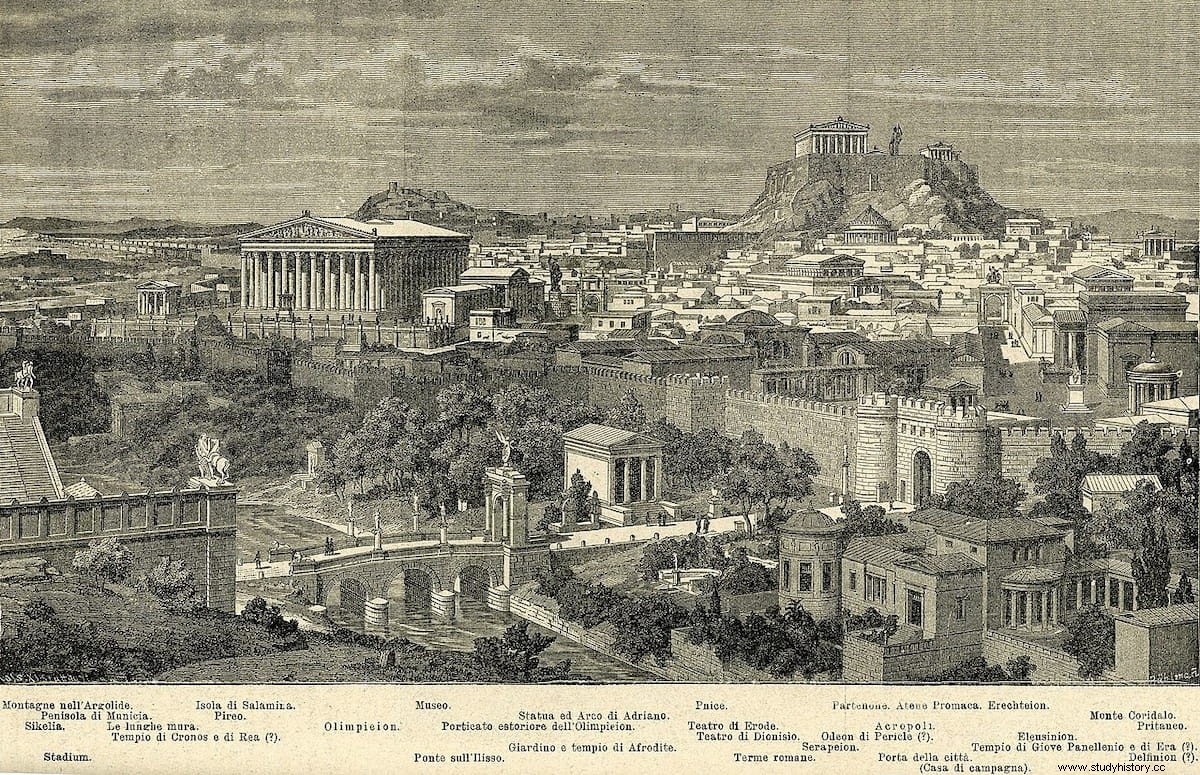
The speusinioi They dressed in the fashion of their land, with colored tunics, wide pants and a Phrygian cap. It is not certain whether they carried their usual equipment (although it is assumed that they did, given the name they received):the compound bow that characterized the Scythian warriors and that they kept, along with the arrows, in the no less typical gorytos (a profusely decorated leather quiver). They probably didn't need the leather chestguard -sometimes with scale mail on top-, shield, javelin and sagaris (axe) that they used in combat. Much less the horse, despite being so linked to that town, since the scope of action was strictly urban.
Instead, they did wear their traditional acinaces (short sword) and a whip, a symbol of authority (“…I had to wipe my tears when I saw an old man being beaten by another man, an archer” it is read in the Suda ) which, however, they lacked by themselves, given the low prestige they enjoyed due to their social status as slaves. It was, therefore, a force of direct intervention for any eventuality, similar to that of the doriforos (guards of the tyrants), but always bearing in mind that they were not the only one to exercise police functions in Athens and that the most level (guarding the Acropolis, for example) were in charge of other forces made up of citizens.
In that sense, their interventions would only be by order of the Eleven, although they did not have them exclusively at their orders but also other security forces. The Eleven were magistrates (eleven, obviously) dedicated to managing arrests and executions, as well as the preservation of public order in certain areas; This is the case of the Boulé and the Ekklesía (that is, the Council and the Assembly), where preventing the wrong person from taking the floor, serving as mediators with the ambassadors and monitoring the entrance would be their main powers, under the orders of the prytans. They carried it into practice through the Scythian archers.
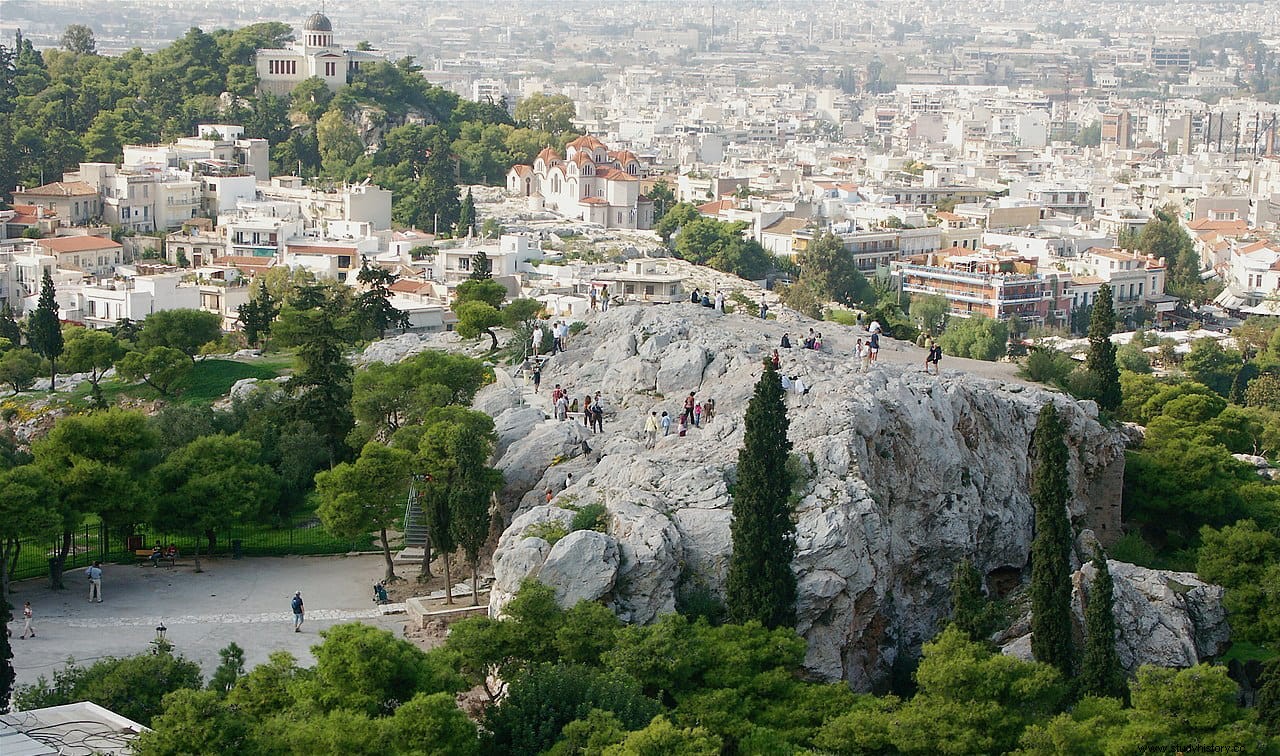
In Memorabilia , Xenophon recounts that Glaucon, son of Ariston, was expelled from the Assembly for trying to speak out by running for the city despite not having completed the required twenty years. Aristophanes himself, in his play The Knights , includes a scene in which the Pritans and Scythians force the Paphlagonian Cleon out of the Boulé and replace him with a blood sausage vendor for proposing to listen to the Spartan peace offer. Likewise, in another of his comedies, Los acarnienses , the archers evict the negotiator Amphitheater from the Assembly.
The comedies of Aristophanes (those already cited plus Lysistrata ), show a negative image of the archers, according to their condition as barbarians:brutes, cowards, lustful and clumsy when speaking; inferior to the Greeks, therefore, their submission being justified. Precisely in Lysistrata they appear, led by one of the ten commissioners chosen after the defeat of Sicily in 413 BC, confronting the women, who make them recoil indignantly at the idea of being repressed by slaves.
Paradoxically, they also had to obey the instructions of the six lexiarchs (magistrates in charge of registering or registering Athenian citizens who, due to their age and other circumstances, had the right to freely administer their property). We say that it is paradoxical because if before they expelled or restricted the passage to the Assembly, in this other task they had to force the people to attend. It is possible that they were in charge of laying the red rope that exposed the latecomers to fine them (or deprive them of the payment that was made for assistance), although the only references that are preserved in this regard, Julius Pollux and Hesychius, do not specify it. .
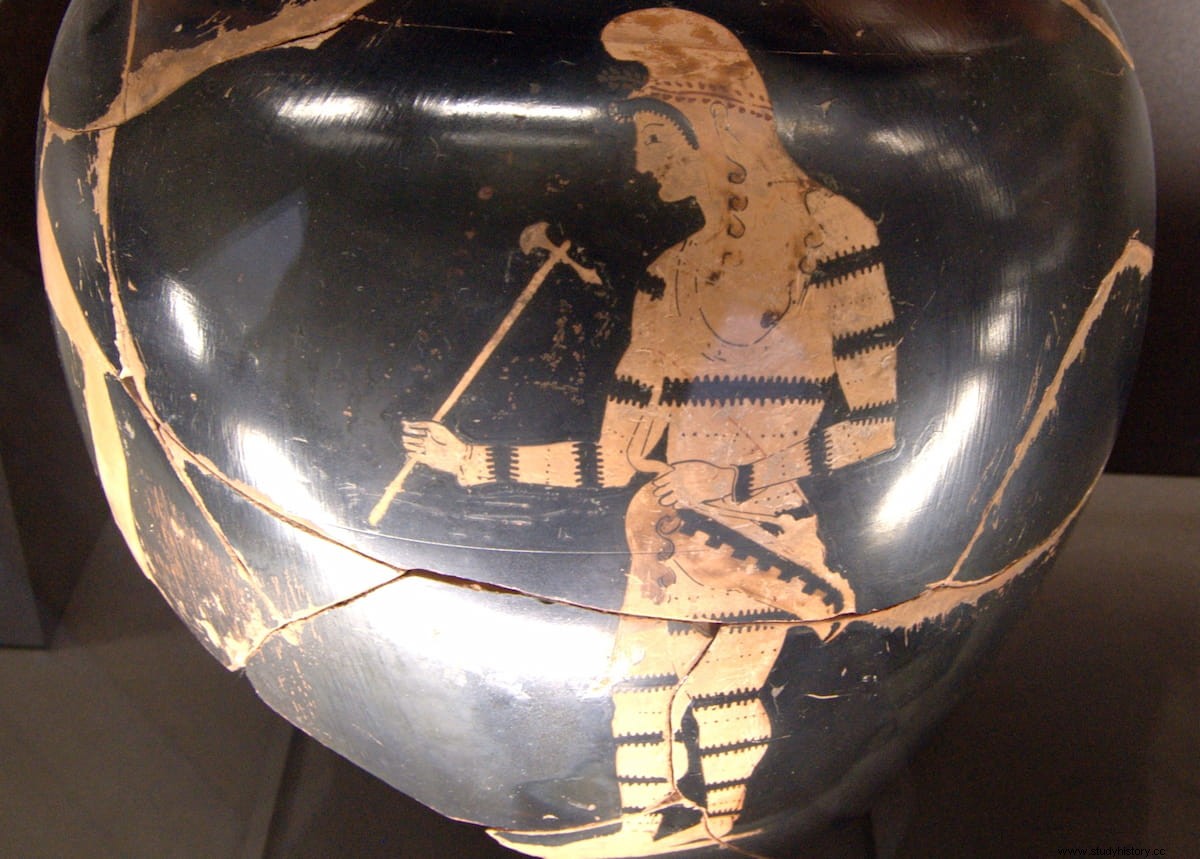
The problem is the lack of specificity of the information available, due to the scarcity of sources. Scythian archers are not listed in the Constitution of the Athenians , that legislative anthology compiled by Aristotle and his pupils between 330 and 322 B.C., so, basically, they only appear on stelae such as the Getes one, burials or, as we have seen, some texts, separate Aristophanic literature (On the mysteries , of Andocides; Memorabilia. Memories of Socrates , of Xenophon; fragments of Hesychius; Onomastic or Julius Pollux). Enough to prove its existence perhaps, but not to know when the body was born (5th or 4th century BC?) or how long it lasted.
Regarding the latter, the speusinioi they disappeared from all review, without further ado, from 390 B.C. (possibly due to the economic crisis suffered by the polis after the Peloponnesian War). And they did so without any evidence of having been replaced by another force, although it was similar to other changes:from 411 BC, the Boulé became a council of four hundred members instead of five hundred, chaired by five prohedrons (not to be confused with the Byzantine high ecclesiastics).
Perhaps the powers of the Scythian archers were assumed by public slaves assigned to each magistrate, with their respective parcels well specified. In fact, in a manuscript of Lysistrata found a scholion (marginal note) which stated that the Athenians called all public slaves Scythians.
